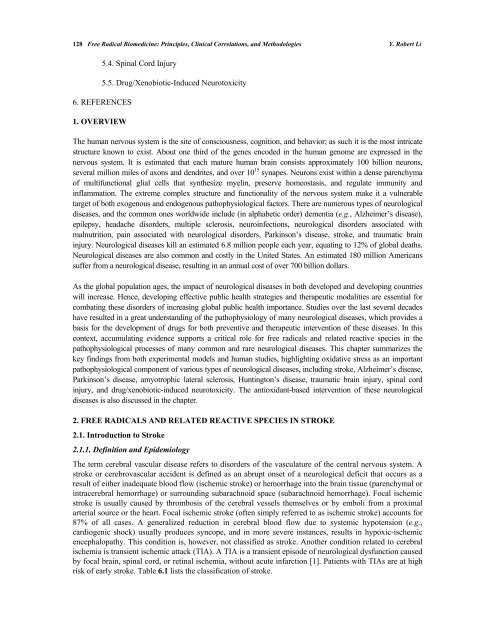Free Radical Biomedicine: Principles, Clinical ... - Bentham Science
Free Radical Biomedicine: Principles, Clinical ... - Bentham Science
Free Radical Biomedicine: Principles, Clinical ... - Bentham Science
Create successful ePaper yourself
Turn your PDF publications into a flip-book with our unique Google optimized e-Paper software.
128 <strong>Free</strong> <strong>Radical</strong> <strong>Biomedicine</strong>: <strong>Principles</strong>, <strong>Clinical</strong> Correlations, and Methodologies Y. Robert Li<br />
5.4. Spinal Cord Injury<br />
5.5. Drug/Xenobiotic-Induced Neurotoxicity<br />
6. REFERENCES<br />
1. OVERVIEW<br />
The human nervous system is the site of consciousness, cognition, and behavior; as such it is the most intricate<br />
structure known to exist. About one third of the genes encoded in the human genome are expressed in the<br />
nervous system. It is estimated that each mature human brain consists approximately 100 billion neurons,<br />
several million miles of axons and dendrites, and over 10 15 synapes. Neurons exist within a dense parenchyma<br />
of multifunctional glial cells that synthesize myelin, preserve homeostasis, and regulate immunity and<br />
inflammation. The extreme complex structure and functionality of the nervous system make it a vulnerable<br />
target of both exogenous and endogenous pathophysiological factors. There are numerous types of neurological<br />
diseases, and the common ones worldwide include (in alphabetic order) dementia (e.g., Alzheimer’s disease),<br />
epilepsy, headache disorders, multiple sclerosis, neuroinfections, neurological disorders associated with<br />
malnutrition, pain associated with neurological disorders, Parkinson’s disease, stroke, and traumatic brain<br />
injury. Neurological diseases kill an estimated 6.8 million people each year, equating to 12% of global deaths.<br />
Neurological diseases are also common and costly in the United States. An estimated 180 million Americans<br />
suffer from a neurological disease, resulting in an annual cost of over 700 billion dollars.<br />
As the global population ages, the impact of neurological diseases in both developed and developing countries<br />
will increase. Hence, developing effective public health strategies and therapeutic modalities are essential for<br />
combating these disorders of increasing global public health importance. Studies over the last several decades<br />
have resulted in a great understanding of the pathophysiology of many neurological diseases, which provides a<br />
basis for the development of drugs for both preventive and therapeutic intervention of these diseases. In this<br />
context, accumulating evidence supports a critical role for free radicals and related reactive species in the<br />
pathophysiological processes of many common and rare neurological diseases. This chapter summarizes the<br />
key findings from both experimental models and human studies, highlighting oxidative stress as an important<br />
pathophysiological component of various types of neurological diseases, including stroke, Alzheimer’s disease,<br />
Parkinson’s disease, amyotrophic lateral sclerosis, Huntington’s disease, traumatic brain injury, spinal cord<br />
injury, and drug/xenobiotic-induced neurotoxicity. The antioxidant-based intervention of these neurological<br />
diseases is also discussed in the chapter.<br />
2. FREE RADICALS AND RELATED REACTIVE SPECIES IN STROKE<br />
2.1. Introduction to Stroke<br />
2.1.1. Definition and Epidemiology<br />
The term cerebral vascular disease refers to disorders of the vasculature of the central nervous system. A<br />
stroke or cerebrovascular accident is defined as an abrupt onset of a neurological deficit that occurs as a<br />
result of either inadequate blood flow (ischemic stroke) or hemorrhage into the brain tissue (parenchymal or<br />
intracerebral hemorrhage) or surrounding subarachnoid space (subarachnoid hemorrhage). Focal ischemic<br />
stroke is usually caused by thrombosis of the cerebral vessels themselves or by emboli from a proximal<br />
arterial source or the heart. Focal ischemic stroke (often simply referred to as ischemic stroke) accounts for<br />
87% of all cases. A generalized reduction in cerebral blood flow due to systemic hypotension (e.g.,<br />
cardiogenic shock) usually produces syncope, and in more severe instances, results in hypoxic-ischemic<br />
encephalopathy. This condition is, however, not classified as stroke. Another condition related to cerebral<br />
ischemia is transient ischemic attack (TIA). A TIA is a transient episode of neurological dysfunction caused<br />
by focal brain, spinal cord, or retinal ischemia, without acute infarction [1]. Patients with TIAs are at high<br />
risk of early stroke. Table 6.1 lists the classification of stroke.

















